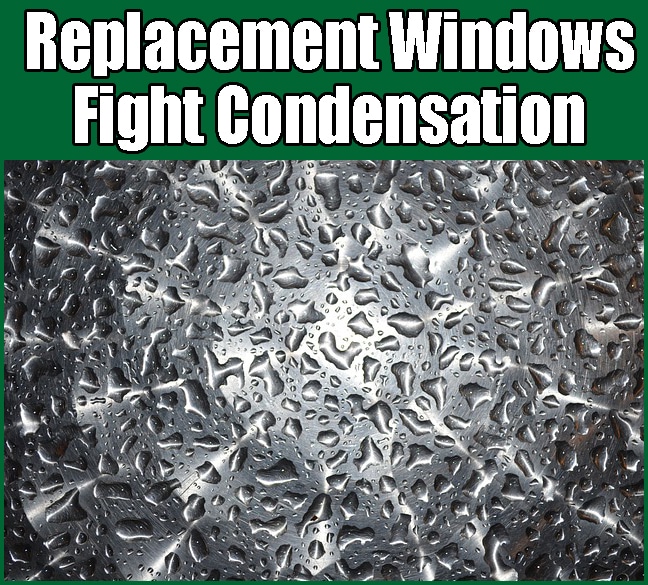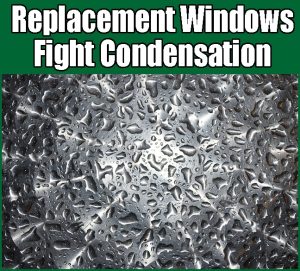


It’s persistent and often misunderstood problem for some homeowners.
Simply put, condensation is a humidity (moisture) management issue.
Understanding Window Condensation
Sometimes, excessively high humidity levels inside your home cause condensation to form, but if you find water, frost or even ice on your windows, especially if it’s between glass panes, your windows may be failing.
Interior Condensation. Humid air retains water vapor until it comes in contact with a surface that has an equal or lower dew point. When humid air collides with interior surfaces with a lower dew point, the vapor turns to liquid, or ice in extreme winter weather. When interior surfaces warm up, or the air dries, condensation disappears.
Exterior condensation develops when the surrounding air temperature is higher than the temperature on glass panes. This is commonly seen as a warm day transitions into a much cooler night.
Even without obvious damage, windows may develop condensation when conditions are perfect. Older home windows and damaged windows should be replaced if you see evidence that condensation is damaging curtains, walls, frames or other items in and around your home. Excessive moisture encourages rot, mold formation and has other health risks.
Renewal by Andersen of New Jersey & New York Metro Condensation Solutions
High-performance replacement windows minimize condensation by incorporating design features to control surface temperatures. By reducing heat transfer (thermal transmittance) of the entire window unit, condensation is less annoying and less destructive. Low-E coatings and gas fills between glass panels improve the U-factor and deliver high-performance, energy-efficient home improvement products that reduce the possibility of condensation forming on interior glass surfaces.
U-factor ratings refer to the complete window – frame, glazing and spacers or fillers between panes. Renewal by Andersen’s high-quality, double pane windows are extremely efficient and normally have a maximum U-factor rating of 0.30.
Tip: When comparing replacement windows and patio doors, check the U-factor. The higher the number, the more likely the window is to form condensation. In New York and New Jersey, where both heating and air conditioning are used in most homes, a rating between 0.30 and 0.35 is considered an acceptable value. Some triple pane window models may have ratings as low as 0.15.
Addressing All Thermal Zones for Condensation Control
Windows have three thermal zones – center of glazing, the edge of glazing and the window frame. Heated air inside your home “seeks” the least efficient zone. This zone is the area where condensation is most likely to develop because surface temperature is lower than the room air temperature.
Here are three things to consider when selecting and designing replacement windows.
Minimal condensation doesn’t necessarily mean your windows must be replaced immediately, or that your windows are defective. You may try to control humidity levels in your home first to see if that reduces the condensation problems. Better ventilation and exhaust fans in the kitchen and bathrooms, where moisture is produced are the first steps to consider in excessively humid homes. An abundance of house plants can also add to humidity levels indoors.
If you aren’t confident your current windows are performing well enough to allow you to control condensation, we can help. We offer a free, no-obligation in-home inspection to check all home windows and patio doors. During our visit, we’ll carefully inspect each unit for leaks and damage. If we find problems, we’ll explain the best way for you to remediate any issues.
Please accept our invitation to schedule a walk through today. Reach us during normal business hours by calling (866) 609-5033 for immediate assistance or fill in the short form on this page and we’ll get back to you as soon as possible.

Learn Everything You Need to Know BEFORE Buying Replacement Windows